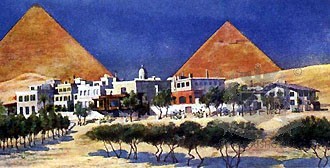

The Great Pyramid of Giza, the only wonder of the ancient world still in existence - and in front of it stands Mena House.
Mena House
The Mena House presented us with a remarkable challenge — we had to verify its opening date which appeard to be wrong (1865?). We unearthed its true opening date, had to alter the published date from 1865 to 1896, and came across some legendary stories of greatest entertainment value.
The hotel stands in front of the Great Pyramid in Cairo, Egypt - the last remaining of the seven wonders of the ancient world. We recommend to take a room with a balcony facing the pyramid. Visit the 18-hole golf course, which due to regular irrigation in the early hours of the day is like an oasis at the edge of the desert. You'll enjoy cool and pleasant conditions, even during the sweltering heat of August. Perfect to spend the winter.

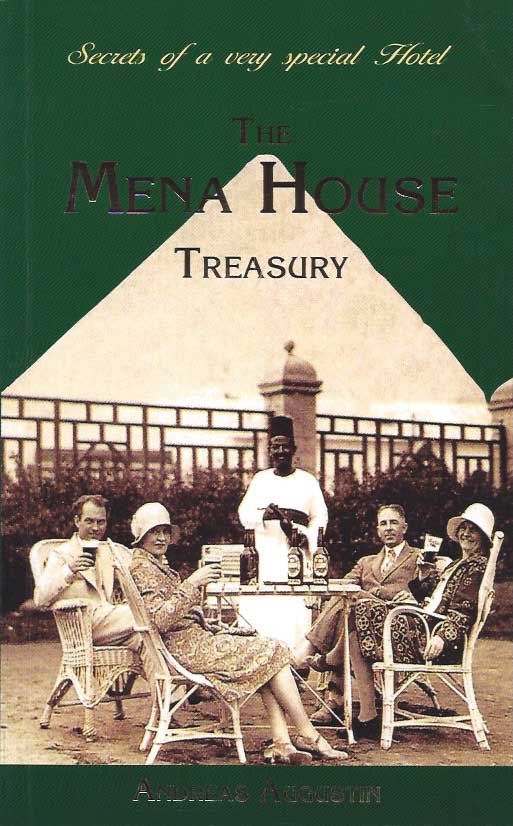

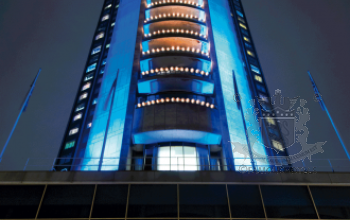
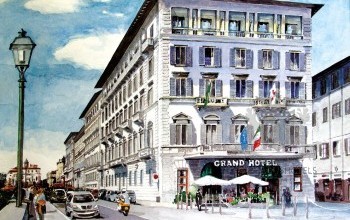
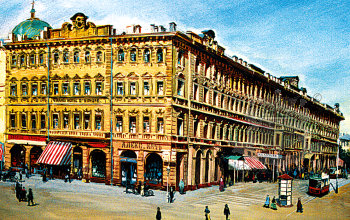
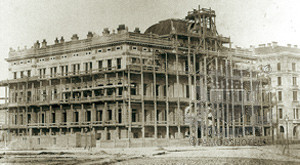
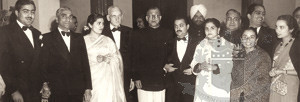

HISTORY
1883 Frederick and Jessie Head, acquired a former Khedival hunting lodge near the Great Pyramid, nicknamed the Mud Hut.
In 1884, the English couple Locke-Kings bought the house from the Heads and decided to construct a hotel next to it.
From 1884–1886, they built a magnificent oriental palace facing the Pyramids, complete with Arab mashrabia windows, brass embossed doors, blue tiles and mosaics of coloured marbles and mother-of-pearl. The great dining hall was an exact replica of a Cairo mosque.
1886: ‘Mena House’ opened. The first guests arrived by coach from Cairo, and soon word spread that there was a new hotel right next to the Great Pyramid.
Austrian Baron Ernst Rodakowski, a friend of Locke-King, was made the first manager of the Mena House.
1889, 4 November: His Royal Highness, the Prince of Wales had been welcomed by His Highness the Khedive, who showed him the Pyramids. Lunch was served at the old ‘kiosque’ of Empress Eugenie. After lunch, The Egyptian Gazette reported, they ‘went over to the Mena Hotel and took coffee there.’
1895–1896: author Arthur Conan Doyle (Sherlock Holmes) arrived for the winter season of 1895-96 at the Mena House Hotel.
1896: The hotel had lawn tennis, two croquet lawns, shooting, stables with Arab and English horses and desert carts for hire.
Fresh milk came daily from their own dairy with medically-examined cows.
1900: Four tramways were traversing Cairo and a fifth was being built to run from Giza to the pyramids.
1904: Mena House goes to the George Nungovich company combining the Angleterre, Savoy, Grand Continental and Mena House hotels.
1909: Empress Eugénie, the widow of Napoleon III, arrived for a second visit to the Pyramids.
1926: Baron Malcolm McDonald and his secretary, Joplin Sinclair, visited the Mena House and leave a remarkable account of "opulent elegance in desert nights", largely influencing Agatha Christie's "Murder on the Nile".
1939: World War II broke out. The Mena House filled with servicemen (Australians).
1942: In July, the British were pushed back nearly as far as Alexandria. German tanks (Rommel) stopped at El Alamein. In November, Field Marshal Montgomery – with his Eighth Army – won the battle of El Alamein.
1943: Plans for Overlord, the invasion of Europe, had to be discussed by Churchill and Roosevelt. Operations in Southeast Asia needed consultation with General Chiang Kai Shek. The Mena House Hotel became the headquarters of the conference and the venue of all the British and American Chiefs of Staff. The Mena House was a fortress, with some 500 anti-aircraft guns protecting the surroundings. There was even an RAF observation post on top of Cheop’s Pyramid.
1950s: The Egyptian monarchy had become synonymous with scandal and moral decadence. British domination was finally intolerable
A group, called Free Officers, started their conspiracy against Farouk.
In 1952, he was forced to flee the country on his royal yacht. His son Fouad was declared king; his reign didn’t last long and one year later, in 1953: The Free Officers declared Egypt a Republic.
1971: When the Oberoi chain identified the hotel as a possible property, the by now nationalised Mena House was in a poor state of health. The Indian Oberoi Group took over the management of the establishment, adding it to their worldwide chain. The hotel was meticulously renovated and expanded. Under the Oberoi management, the hotel reached the highest standards of international hotels and eventually became a select member of The Most Famous Hotels in the World.
1972: Closure of the Mena House and total renovation under Oberoi. Mena Gardens opened in December. Together, the two hotels were called Mena House Oberoi.
1974: US president Richard Nixon lunched at the Mena House.
1975: The Suez canal reopened. In December, renovation work on the Mena House was completed (total cost: £3m. Architect: Amr El Alfi). On Christmas Day 1975, the hotel was reopened by Prime Minister Mamdouh Salem. The famous front terrace now comprised two floors, all air-conditioned and behind huge glass windows, with the foyer below and a coffee shop above. The hotel had retained old tradition by keeping the lovely Moorish vaulting, the original chandeliers and the irreplaceable Mashrabia.
1978: 200-room extension at Mena House completed (garden wing). On 26 March Sadat signed the Camp David Accords, shaking hands with Menachem Beghin on the White House Lawn and ensuring the return of Sinai to Egypt.
1979: Mena House was chosen as the venue for the Egypt-Israel talks, following Anwar Sadat’s peace ini-tiative. Menachem Beghin occupied suite 908, while Jimmy Carter was in the Churchill Suite and Sadat in the Montgomery Suite. The hotel was fully closed for the public and open only to delegates. Every visitor, including children, needed a pass-badge. Thanks to the security, a suitcase with a bomb was detected in time. For the Israeli participants, exclusively kosher food was served. Jimmy Carter addressed the meeting. On that occasion the Egyptian and American President were each presented with a key of pure gold by the management of Mena House, in gratitude for the privilege of playing host. Carter, however, returned the present the next day, as a US president (at that time) wasn’t allowed to accept presents worth more than US$50.00.
That year Newsweek picked Mohan Singh Oberoi as ‘Businessman of the Year’ (with low-budget flyer Sir Freddie Laker and Roland Peugeot.)
1986: TABA negotiations between Israel and Egypt at Mena House.
1992: The UPUAUT project sent a little robot into the airshafts of the Great Pyramid. No news.
1993: A series of conferences (Two States, One Holy Land, etc.) were held at Mena House.
1995: The success of the ‘Reading for All Initiative’, sponsored by Mrs Mubarak (below, welcomed by general manager Rajiv Kaul, 1996–2003), brought books to the countryside and poor urban areas, making it possible for underprivileged children to read to their heart’s content. The project also included the reprinting and mass distribution of numerous books, both classics and previously little-known gems, at affordable prices. 2000: In April, the leading Egyptologists held their World Conference in Cairo. 1,500 members attended and the Mena House was quite naturally at the centre of the action. The conference facilities of the Mena House were put to test. The climax was a banquet arranged by the Mena House at the foot of the Sphinx.
2005: Extensive renovations of the Garden Wing.
2013: Oberoi withdraws from the hotel's management.
2017: Marriott takes over the management of the Mena House.
Among the many famous guests to have graced Mena House over the years:
From the World of Politics The Shah of Persia – he stayed at Mena House in 1980 after being forced into exile by Ayatollah Ruhollah Khomeini Duke of Windsor Barbara Bush Jimmy Carter Richard Nixon Field Marshal Bernard Law Montgomery (‘Monty’) William Cohen HRH Sofia Queen of Spain Sheikh Yamani
From the World of Entertainment Charlie Chaplin Omar Sharif Hani Shaker Brooke Shields Adel Imam Frank Sinatra John Travolta Gloria Gaynor Dalida Grateful Dead Earth Wind & Fire Village People Julio Iglesias Charlton Heston Cecil B. DeMille
From the World of Literature Sir Arthur Conan Doyle William Faulkner
From the World of Sports Nick Faldo
Did You Know That? . . .
...in ancient times there was a king called Mena the ‘Constant’, who lived around 4400 BC? Mena – also known as Aha or King Menes of Memphis – was the founding king of the first dynasty and was the first king to unify Upper and Lower Egypt into one kingdom. Ancient Egypt’s most predominant form of civilisation began with his crowning, and did not end permanently until the beginning of the Roman era, which started with Augustus Caesar. Mena founded the city of Memphis, and chose as its location an island in the Nile, so that it would be easy to defend. During his time, Egypt expanded his sphere of influence as far as the First Cataract.
...during the 1880s it was customary to charge for extras like a hot or cold bath in the bathroom ( each 5 piastres) or a lamp in the bedroom (each 5p)?
...in 1919, the Mena House staff furnished 30 new rooms with newly arrived furniture (23 December) for all the arriving guests (24 December) within 24 hours?
...during the 1920s, manager Oscar Geyer reared 20 hens and one cockerill in the garden behind the hotel to ensure a supply of fresh eggs?
...a gardener during the 1920s was paid 10 piastres for each eucalyptus tree (very delicate - needs an endless supply of water), but was fined 20 if one died? A small forest behind the hotel is the result.
...while digging a bunker for the golf course in 1922, a little urn with some ten statuettes was found? It was ‘only’ about 2,000 years old.
...King Farouk always spoke Italian with the head waiter Bennini, when ordering a plate of his favourite spaghetti in thick tomato sauce?
... an Australian officer during World War 1 was caught chasing a woman through the corridors of the Mena House? He was totally naked. When questioned, he quoted an army regulation to the effect that an officer may wear any costume appropriate to the sport in which he is engaged at a given time.
...the hotel’s most notable inhabitant of a very small room is the oldest palm tree on the premises? The tree received its own little room on the ground floor, where its 100 years old roots are steeped in historic sand.
...the old Mena House lifts were nicknamed the 'please and thank you contraptions', because they only seemed to oblige if such courtesies were extended to them? The antiquated lifts especially disliked VIPS - many a celebrity got trapped in them, including the OPEC leader Sheikh Yamani. Thankfully, Oberoi replaced them back in the 1970s.
... in 1985 Egypt awarded M.S. Oberoi its highly coveted Order of the Republic award in recognition of his outstanding contribution to tourism in the country?
... M.S. Oberoi pioneered the employment of female staff in his Egyptian hotels? He had tour-operators conduct a house-to-house survey to find out which women had graduated from college, but were now sitting at home and wasting their degrees. Many of these were then offered jobs. Mr Oberoi insisted on having personable young women in his hotels.
... Hollywood star Mena Adrienne Suvari (right: ‘American Beauty’) was named after her British Aunt, who was christened after the Mena House?
... the Kataab family has run the antiques shop at the hotel since the hotel opened? Grandfather Ibrahim was a well known Egyptologist himself, and the generations to follow inherited his love for antiques.King Gustav of Sweden was a true archaeologist and while at the Mena House viewed the Kataab collection
... before the modern pool was installed, the old marble swimming bath was emptied by hand, cleaned and refilled every night? One night the pool was used for a fishing competition, live carp from the Nile were brought in and the first guest to catch one was the winner? That night saw many men in wet dinner jackets.
... there are sometimes functions with over 1,000 people in the hotel’s ballroom?
...Mena House is among the most decorated hotels in the world? It has been awarded with accolades stretching from ‘The Best Hotel in the World’ to ‘The Most Beautiful Gardens of Cairo’.
... what is occasionally referred to as pollution over Cairo is rarely smog but dust and sand?
... the gardens are kept in shape by the team of head gardener Abdul Hamid, who joined the Mena House in 1976?
... a helicopter once landed on the lawn of the Garden Wing? The pilot got out and asked for the restaurant.
... the settlement around the hotel, nicknamed Mena village, is actually called Nazlet-el-Samaan, the ‘Heaven of the Quail?
... the best time for quail is March and April? The best place is between Mena House and Sakkara?
Some more stories?
Sir Peter Ustinov, actor and author, enjoyed the story of King Zog and Queen Geraldine of Albania, who had spent seven months at Mena House in 1946. King Zog’s private secretary had a huge safe for the court’s treasures brought especially from Cairo, so large that it had to be pulled up to their apartment on the outer walls of the building.
Sheik Mohammed bin Rashid el Maktoum, a great horseman and one of the leading figures of the Arab world, has made a tradition of his horse race in the desert around the Pyramids. The Mena House is in charge of setting up the spectacle: from tents to food, everything is in the experienced hands of the hotel.
In 1923, Peggy Guggenheim asked the management to prepare an excursion into the desert. A caravan of camels was chartered, servants, a chef, tents, furniture such as camp-beds, and washing dishes were loaded and off they went for a delightful trip into the desert behind the Pyramids. For a short while she even left her children, Sindbad and Lilly, at the hotel to travel to Jerusalem. His Imperial Highness, the Crown Prince of Japan and his wife were welcomed by Rajiv Kaul. Karim Aga Khan arrived – as many times before his late father, who frequented the hotel with his wife Begum. Maurice Bejart, the ballet director, enjoyed his stay. Broadcaster & author Bonnie Churchill was walking in the footsteps of her granduncle.
Jane Fonda visited the Montgomery Suite and enjoyed her lunch at the Mena House. The famous Egyptian singer Um Kalthoum patronised the hotel as well as Allan Moorhead, the author of ‘African Trilogy’.
Omar Sharif is of course the pride of Egypt. The charming and elegant Hollywood movie star who once said ‘I’d rather play bridge than make a bad movie’ is a regular at the Mena House, and the darling of the staff.
Singer Hani Shaker actually performed at the Mena House for a while before becoming one of the most respected stars of Egypt. Everybody remembers beautiful Brooke Shields, who paid her tribute to the hotel, too.
Mena House has welcomed more than once Egyptian Adel Imam, the celebrated comedian, screen and stage personality. Renown for his anti-terror point of view and thus a target of terrorism himself, he usually arrives well protected by governmental security guards. Adel Imam Have you heard of Dr Zaki Souidan? He was a doctor of international repute. His first practice was near the hotel. Often he was asked to look after guests, and of course, sometimes after the staff. During the 1943 Churchill, Roosevelt and Chiang Kai Shek conference at Mena House, the chef de cuisine was not feeling very well and had to visit Souidan several times. One night the chef came to pay his bill: he arrived with a large jar of caviar which he presented to the doctor. Zaki looked at it surprised and asked where it came from. ‘Well’, said the chef, ‘Stalin sent three jars to Mena House for Mr Churchill, and I thought two were enough for him.’
Did we discover the largest pyramid ever built? Near the Mena House Hotel, one of its regular guests, Dr. Zahi Hawass, discovered the Pyramid of Djedefre, or the so-called lost fourth pyramid. It was constructed on a hilltop at Abu Rawash, from which the Giza Plateau is visible. Today, little is left of Djedefre's pyramid and there is no evidence to explain why it was built at Abu Rawash and not Giza, the site of the Great Pyramid, which was constructed for Djedefre's father, King Khufu.
Mixed Grill: Observing the happenings at the Oasis Barbecue Restaurant with the light effects at the Pyramids in the background, an impressed visitor uttered one evening: ‘There is an American couple swinging to an Austrian waltz played by an Egyptian violinist under the sparkling sky of Northern Egypt with the Star of the South over the horizon, dining Lebanese Mezzah on Royal China from Thailand served by a Nubian waiter. I call that Mixed Grill at Cairo.’
Inspiration: Charlie Chaplin spent a whole week at the Mena House, finding the place so inspiring that he continuously worked on a script for a new film there. At the end of his stay, he gave a cocktail party on the terrace.
Harry Mulisch, the best-selling author of The Procedure, has his main character Victor Werker spending a lot of time at the Mena House, were he sees Jacqueline Onassis and a group of friends (‘I have seen the owners of the world’).
An early view of the Mena House (dating from ca 1890) by postcard artist Klamroth shows the fabled hunting lodge of the Khedive Ismail Pasha. This ‘alpine style’ lodge – to the very right of the painting – was the first building on these grounds and the private residence of the first owners of the Mena House.
William Faulkner, the famous American Author and Noble prize winner stayed at Mena House during the filming of 'The Land of the Pharaohs'.
The crew of the movies The Ten Commandments stayed at Mena House for 3 months during shooting of the film, back in 1954. Cecil B. DeMille and Charlton Heston. President Nasser personally extended full support to the movie crew.
One of the cadies at the Golf course (Hassan Gomaa) worked at the golf course since he was 10 years old. He was among a group of extras in the same movie, the film crew paid him 9 pounds a day. He used to serve Cecil B. DeMille and Charlton Heston as well the other crew members Rum with Coca Cola at the course.
From THE MENA HOUSE TREASURY © Andreas Augustin / famoushotels.org
On location: Large parts of Valley of the Kings with Robert Taylor and Eleanor Parker were shot at the Mena House. Roger Moore, who stayed here during the shooting of The Spy Who Loved Me in 1977, confessed to the guest-book during a second stay: ‘How nice to be here as a guest & not have to jump around as 007!’ Bar keeper Aziz Fouad was in charge of the Martinis.
Charlton Heston (the Treasury book shows a picture of him with riding coach Mohammed Allan Gabri) appreciated upon his return that the lobby hadn’t changed ‘from when I rode a horse into the garden every afternoon after shooting the Ten Commandments’.
The Arabian classic Hekayat hub (Love Story) is also set at the Mena House (with Myriam Fakhr Eddine), so is Sahib el galala (His Majesty) with Samira Ahmed. The Movie ‘Flatfoot in Egypt’ (Bud Spencer and Terence Hill) was filmed at the Mamlouk Bar and Khan El Khalili.
Managing the Mena House
Ernst Baron Rodakowski: 1887–96
G.A. Loedlick
Schick
Emil Weckel 1896–1904
George Nungovich Egpytian Hotels (later: Egyptian Hotels Ltd.) August Wild
Freddy Elwert (ca 1918)
Oscar Geyer (1920s)
Fred Herrling 1932
Milo Niederhauser
Joseph Soly
Charles Mueller
Herbert Canoudi
G Fittikidis
Papadopoulo
Schrock (1962)
Ahmed Assaad (1967)
Ratan Tata (1972–75)
Homi Wadia (1979–1982)
Kaval Nain (1982–1985)
Ibrahim Dessouki (1985–1988)
Shankar Mani (1988–1992)
Satish Kumar (1992–1996)
Rajiv Kaul (1996–2003)
Sanjiv Malhotra (2003-2008)
Mohit Nirula
Omar Tantawy
500 Rooms
20 Suites
Churchill Suite -------- Montgomery Suite
Al Rubaiyat
Khan el Khalili
Moghul Room
Oasis Restaurant at the Pool
Abu Nawas nightclub
2 bars
Location, location, location . . .
Did we discover the largest pyramid ever built? Near the Mena House Hotel, one of its regular guests, Dr. Zahi Hawass, discovered the Pyramid of Djedefre, or the so-called lost fourth pyramid. It was constructed on a hilltop at Abu Rawash, from which the Giza Plateau is visible. Today, little is left of Djedefre's pyramid and there is no evidence to explain why it was built at Abu Rawash and not Giza, the site of the Great Pyramid, which was constructed for Djedefre's father, King Khufu. According to archeologist Zahi Hawass: "The pyramid itself was planned as a relatively modest structure with steep sides& It is usually assumed that Djedefre did not have access to the resources commanded by his father and later by his brother Khafre; it is equally possible that he was fairly advanced in age when he came to the throne? knew that he might not have time to finish a more ambitious project." Researchers have also found remnants of a mortuary temple, boat pit, queens' pyramids, statues and a lengthy causeway around the pyramid complex. Although it's been speculated that Djedefre's pyramid was dismantled after his death because he was an unpopular figure, researchers have indicated a more likely explanation is that the pyramid was plundered for its stones by subsequent societies. "Traveller, when you go to Egypt, take a room at the Mena House and spend time sitting on your balcony watching the Great Pyramid. Start early in the morning and look at it again before you go to bed. You will discover a new silhouette every time you look." Andreas Augustin ‘After an evening at the Mena House hotel, where Gypsies played their melancholic and maddening airs which seem to evoke all of their passions, I went to take another look at the sphinx, under the moonlight. It appeared more imposing, as if transfigured. Beneath the magical moon, its maimed features were repaired. I came back to the hotel terrace. The air was refreshing. The grand tent quivered in the East wind. I sat beneath it, unable to tear myself away from the grandiose emotion of that place, which resembled the sanctuary of the Almighty, or from the ingratiating charm of that clear night, of that heavenly air.’ Edouard Schuré (1898)
There is no better stating place to explore this newly discovered wonder of the world than Mena House. This 1886 hotel sits in front of the Great Pyramid in Cario, Egpyt - one (and the last remaining) of the seven wonders of the ancient world. Why not take a room with a balcony facing the pyramid? You could also try the 18-hole golf course, which due to regular irrigation in the early hours of the day is like an oasis on the edge of the desert. You'll enjoy cool and pleasant conditions, even during the sweltering heat of August.
18 hole golf course -------- Riding -------- Swimming pool -------- Flood-lit tennis courts